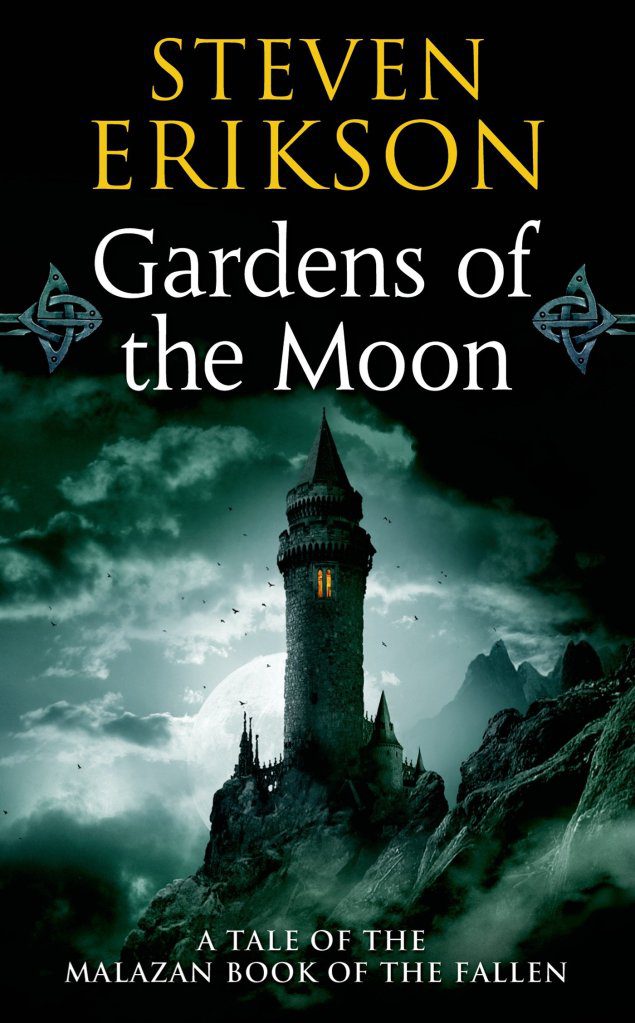
Synopsis
The Malazan Empire simmers with discontent, bled dry by interminable warfare, bitter infighting and bloody confrontations with the formidable Anomander Rake and his Tiste Andii, ancient and implacable sorcerers. Even the imperial legions, long inured to the bloodshed, yearn for some respite. Yet Empress Laseen’s rule remains absolute, enforced by her dread Claw assassins.
For Sergeant Whiskeyjack and his squad of Bridgeburners, and for Tattersail, surviving cadre mage of the Second Legion, the aftermath of the siege of Pale should have been a time to mourn the many dead. But Darujhistan, last of the Free Cities of Genabackis, yet holds out. It is to this ancient citadel that Laseen turns her predatory gaze.
However, it would appear that the Empire is not alone in this great game. Sinister, shadowbound forces are gathering as the gods themselves prepare to play their hand…
Review
“These tales are the tales of us all, again yet again.
We are history relived and that is all, without end that is all.”
It has taken a decade or more for me to bring myself to read Gardens of the Moon; I’ve been staring at it on my bookshelf since before the final volume of the series was released way back in 2011. To put that into context, even if only for myself, I have owned a physical copy of Gardens of the Moon for almost as long as my thirteen year old daughter has been alive and yet I never even opened the front cover until just a few weeks ago. There are many reasons for this, but probably the largest is the buzz surrounding the series. Spend more than a few minutes in any book-related community and you’re bound to get Malazan recommended to you at least three times. You’ll hear buzzwords like, dense, complex, a slog, and brutal. Which is not to say it isn’t those things. It is! But, in a good way. Let me explain.
Gardens of the Moon doesn’t hold your hand throughout its odd 600 pages. From the prologue, the reader is dropped into a world with hundreds of thousands of years of history, a cast of characters to put most Dramatis Personae to shame, and a plot which takes careful reading and some mental leaps in order to wrap your head around it. I feel like the process of reading GotM made me a better reader. I had to read more carefully and more critically than I normally would have. Never before have I been confronted with such a wholly unique world, but the world of Malazan Book of the Fallen is just that. Erikson is a trained archaeologist and anthropologist and this shows in the breadth and depth of the world that he created. There are layers upon layers of history and backstory and it makes you feel as if there is always something more to be gleaned from the page; there is always something new that you can learn about the history of this world. There are whole histories of unique races and civilizations and this is used to flesh out the world and to great effect.
“Every decision you make can change the world. The best life is the one the gods don’t notice. You want to live free, boy, live quietly.”
“I want to be a soldier. A hero.”
“You’ll grow out of it.”
You may think that with such a large world and cast of characters that individual characterization is lost, but it isn’t. While the characters themselves certainly aren’t the main focus of the story, they are all mostly fleshed out, with their own histories and motivations within the narrative. In the rare instances where Erikson decides to lift back the veil, you really get the feeling that these characters don’t exist just within the confines of the book. The small glimpses into the history of these characters always kept me wanting to know more. You won’t find the farm boy turned hero with the shallow backstory here. Further, we have pantheons of gods who are all too happy to meddle in the affairs of mortals and are playing their own game within the shadows. One thing that especially stuck out to me was how he absolutely nails the dark, cynical humor of the Malazan soldiers. These are no knights in shining armor, just dirty soldiers doing their jobs.
The unadulterated epicness of Gardens of the Moon cannot be understated. Erikson does everything with a sense of scale that most epic fantasy books never reach. Our first taste of action takes place in Chapter Two where we see the Malazan Empire forces breaking the Siege of Pale and exchanging volleys of magic with immortal bada** Anomander Rake, who just so happens to be standing on the balcony of his flying fortress, Moon’s Spawn. Later, a creature hundreds of thousands of years old does battle with no less than five (FIVE!) dragons. Do you see what I mean when I say that the scale of Malazan is truly unprecedented? It serves to create some really magical visuals. It should also be mentioned that Erikson deftly handles small scale battle as well, with several engagements between just a few characters.
“Convergence,” Tool said. “Power ever draws other power.”
Overall, I really enjoyed my time with Gardens of the Moon. Steven Erikson, along with his friend and collaborator Ian Esselmont, has created something truly remarkable. This serves as a great introduction to the sprawling world of Malazan Book of the Fallen and the carrots that Erikson dangles in front of you at every turn only makes you hunger for more. The subtlety of his writing is also something that took me by surprise. There are allusions to future and past events, hints at further plot points, and threads to follow on every page.
Unfortunately, it’s strengths are also some of its greatest weaknesses. It can often stray into the territory of overly complicated. Erikson has even admitted to regretting not holding the readers’ hands more in Gardens. I would never recommend this to a reader that is new to epic fantasy, however veterans of the genre should be able to get through it with relative ease. Just take your time, bask in the epicness, and maybe use a guide. Some of the staff at tor.com did a re-read of the entire series several years ago and it was an invaluable resource for me, even when used as a chapter-by-chapter recap before each new chapter, and I plan to continue to use it as I read the rest of the series. You can find it here.
“The curse of climbing is discovering how great the distance yet to climb.”










Great review, Justin. It is really comprehensive and thoughtful.